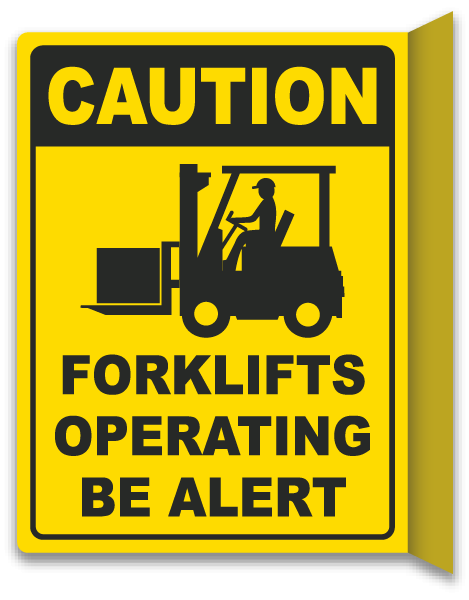Best Practices for Displaying Forklift Truck Security Signs in Industrial and Storage Facility Setups
The application of efficient forklift vehicle safety signs is essential in commercial and storehouse atmospheres, where the risk of mishaps can considerably affect both workers and procedures. What particular strategies can companies embrace to ensure their safety signs genuinely serves its function?
Relevance of Safety Signage
The significance of safety signage in environments where forklift vehicles run can not be overstated, as these signs play a critical role in stopping crashes and making sure the security of workers. Effective security signage works as a crucial interaction tool, sharing crucial details regarding potential dangers connected with forklift procedures. This consists of cautions concerning pedestrian areas, rate limitations, and assigned forklift courses, which are important for keeping an organized and safe workplace.
Correctly presented security signs can boost situational recognition amongst employees, advising them of the risks associated with their environments. They give clear directions on risk-free methods, such as using proper individual safety equipment (PPE) and adhering to operational standards. Safety and security signs contributes to compliance with regulatory demands, assisting organizations avoid charges and promote a culture of security.
Along with their preventative duty, safety and security indicators cultivate a sense of accountability among staff members. When employees understand safety and security procedures and the potential repercussions of overlooking them, they are most likely to take positive steps to secure themselves and their colleagues. As a result, investing in top notch security signs is vital for any type of office where forklift trucks are in operation.
Trick Presence Variables
Reliable visibility is paramount in ensuring the safety and security of both forklift operators and pedestrians in busy work settings. To accomplish this, a number of crucial presence variables should be thought about when creating and putting safety indicators.
First, the size and typeface of the text on the indication play a vital role. Larger font styles boost readability from a range, allowing people to promptly understand the message. Furthermore, using bold and clear typefaces can dramatically improve readability under various illumination problems.

Effective Placement Strategies
Sign placement dramatically affects their efficiency in communicating safety messages within forklift operations. To make best use of presence and understanding, indications need to be strategically positioned in locations where forklift task prevails. Key places include junctions, dead spots, and near loading and discharging areas, where operators and pedestrians communicate frequently.
Elevation is another critical factor; indications need to be put at eye degree to guarantee they are quickly seen by read review both forklift operators and ground employees. In addition, making use of contrasting colors and clear graphics will enhance exposure, particularly in low-light conditions or high-traffic areas.
Consider the circulation of traffic when figuring out placement. Indicators need to be placed to lead operators safely and successfully with the work space, decreasing the threat of mishaps. Regular evaluations must be conducted to make certain that signs stay unblocked by equipment or inventory, as moving formats can diminish their efficiency.
Including feedback from workers regarding indication placement can likewise bring about improvements. Involving team in this procedure cultivates a society of safety and recognition, eventually adding to a more secure dig this work environment. By executing these reliable placement strategies, organizations can improve communication and adherence to safety and security protocols.

Compliance With Regulations
Making certain conformity with guidelines is vital for keeping a secure workplace in forklift procedures. Regulatory bodies such as the Occupational Safety And Security and Health Management (OSHA) and the American National Specification Institute (ANSI) develop guidelines that dictate the appropriate use of security indicators. Adherence to these laws not only promotes safety and security however also alleviates the danger of penalties and lawful responsibilities.
Forklift security indications need to be plainly visible, clear, and purposefully placed according to regulative needs. These signs must use standardized symbols and shade codes to convey essential info effectively. For example, yellow indicates care, while red signals risk, making certain that employees can promptly analyze the check in high-stress scenarios.
Organizations should conduct routine audits to verify that all safety and security signs fulfills present lawful criteria. By ensuring that forklift safety indicators adhere to mandated guidelines, firms promote a culture of security recognition among employees, thereby improving overall work environment safety and productivity.

Routine Maintenance and Updates
Keeping and upgrading forklift security indicators is vital for making certain that they explanation continue to be reliable and appropriate in the work environment. Routine examinations must be conducted to examine the problem of security indicators, as direct exposure to severe commercial atmospheres can result in fading, damages, or obsolescence. Signs that are no longer readable or that consist of obsolete information can substantially weaken security protocols.
It is crucial to establish a regular upkeep schedule that includes inspecting the presence and clearness of all safety signs. Any indicators that are put on, harmed, or misaligned need to be promptly changed or repositioned to keep their efficiency. Furthermore, as regulations and safety and security standards develop, it is essential to upgrade signs to reflect existing practices and compliance demands.
Involving workers in safety and security training sessions can additionally strengthen the relevance of maintaining and upgrading security indications. This not only makes sure that everyone knows the indications' definitions yet also promotes a society of safety within the work environment. By prioritizing regular upkeep and updates, companies can develop a more secure atmosphere and boost the total effectiveness of their forklift safety signs.
Conclusion
In verdict, the implementation of ideal techniques for presenting forklift vehicle security signs is crucial for improving office safety in industrial and warehouse settings. By focusing on presence, employing efficient placement strategies, making certain compliance with policies, and devoting to routine maintenance, companies can dramatically minimize the risk of accidents. Such measures not just connect hazards properly yet additionally foster a culture of safety that benefits all workers entailed in forklift operations.